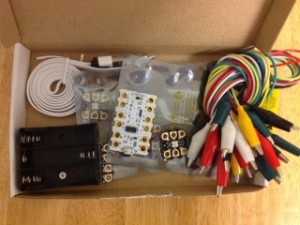I bought a crumble at the Raspberry Jam.
A what? At where . . .?
Sorry: you can’t eat it – and anyway, I would not put raspberry jam in a crumble I would use blackberries. Yesterday I visited ‘Camjam’ in Cambridge. A Raspberry Jam is a sort of Open Day based around the small Raspberry Pi computers. Computers have fascinated me ever since the first micro-computer appeared in my classroom back in the 1980’s and my curiosity has not diminished with age. Even then I realised that the question is not “What does it do?” but “What can I do with it? And the answer still eludes me. Now I have my Raspberry Pi what am I going to do with it? Probably to start with I’ll programme my Doll House lights – which means I’ll need to do some soldering. Many Jams have soldering sessions and the session at Camjam was outside in the glorious sunshine.
The Raspberry Jam was set up with three areas: workshops, talks and vendors, with a refreshment counter in the vendor area. We arrived just in time to grab a coffee and go to the first talk. Only then did I notice the “No food or drink in the lecture theatre” signs! I drank the coffee feeling a bit guilty but no-one commented. I was particularly interested in the first speaker, Steve Foster who spoke about his experiences computing in school. It is so useful to learn from someone else’s experiences – things like leaving the SD card permanently inside the Pi because of its fragility. It was also interesting to learn that the school technicians were not keen to support Pi’s because their expertise lay in Microsoft systems. There were two other talks about computing in schools. Graham Hastings referred back to the years 1983/ 1984 when the BBC Acorn computers were delivered into every primary classroom. He thought that had been a “golden generation” of youngsters who were able to tinker with computers and control what they did. More and more, today’s children are being presented with closed systems that defy tinkering – such as iPads. Graham explained that teaching computing to schoolchildren was justified – the younger the better – introducing algorithms to Key Stage One pupils. The computational thinking skills developed in computing may be applied to real life. I wonder if he has read Seymour Papert’s book, “Mindstorms”? He was talking in the sixties about children using computers as instruments for learning and for enhancing creativity. Back in the late 1980’s, inspired by Papert, I taught my pupils “Logo”.
I found the most inspiring of the three speakers on the subject of working with children to be Mark Calleja from ‘Hack Lab’ with his motto “Think. Hack. Make. Do.” His company sets up workshops for kids and four youngsters sat in the front row of the lecture theatre to enthusiastically back him up whenever he prompted them. His guidelines reflect everything I believe in about teaching children: “Think more, work less; Be excellent each other; Respect your crew; Stretch your brain; Go find out and if you do not know ask three other children before you ask a grownup”. Then he asked the kids what they knew about Wikipedia and they replied in one voice, “Don’t trust it!” After the talk on Bluetooth Beacons by Barry Byford I came away with a better understanding of what they are and how they work – although I have to admit I am still a bit confused about the difference between Wi-Fi and Bluetooth. I’ll have to ask the chaps at SoSlug tomorrow. My favourite talk was lorry driver Andy Proctor whose tinkering with a Raspberry Pi led to a complete change of career. He finished his talk with these words “Find a problem. Fix it. Go out there. Just try it. Even if it does not work you’ve learnt from it. Where will it take you?”
Inspired by the speakers I decide that I had to buy something. Ahah! I found Redfern Electronics’ ‘Crumble’ – a tiny control board – plus their ‘Sparkles’ – neopixels nesting in a bed of easy-to-attach holes much bigger than my teeny Adafruit ones. The Crumble uses code that looks like Scratch / Blockly. Looks much easier to programme than my Gemma.

Now I have found a problem: setting up my Crumble with the Sparkles. But that leads to a bigger problem. What on earth am I going to do with it then?!
 Follow
Follow
Thanks for the kind words! It’s nice to know others have a similar mindset. Once you’ve automated the doll house, you should teach yourself to mod Minecraft with python. If you want to get kids frothing about Raspberry Pi, Minecraft is the way forward! Try here for starters: http://www.stuffaboutcode.com or http://www.arghbox.WordPress.com
-MrC
Thanks for the link. I may try the Minecraft first – there just are not enough hours in the day.